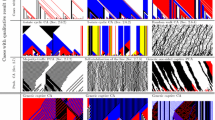Abstract
A formalism based on window automata is proposed as a method to analyse complex population dynamics. The method is applied to a model of the immune network (Weisbuch, G.et al., 1990.J. theor. Biol. 146, 483–499), and used to predict which attractor the system reaches after antigenic stimulation, as a function of the parameters. The attractors of the dynamics are interpreted in terms of immune conditions such as vaccination or tolerance. Scaling laws that define the regimes in the parameter space corresponding to the specific attractor reached under antigenic stimulation are derived.
Similar content being viewed by others
Literature
De Boer, R. J. 1983. GRIND: Great Integrator Differential Equations, Bioinformatics Group, University of Utrecht, The Netherlands.
De Boer, R. J. 1989. Extensive percolation in reasonable idiotypic networks. InTheories of Immune Networks, H. Atlan and I. R. Cohen (eds), pp. 26–37. Berlin: Springer.
De Boer, R. J. and P. Hogeweg. 1989a. Memory but no suppression in low-dimensional symmetric idiotypic networks.Bull. math. Biol. 51, 223–246.
De Boer, R. J. and P. Hogeweg. 1989b. Unreasonable implications of reasonable idiotypic network assumptions.Bull. math. Biol. 51, 381–408.
Hood, L., I. Weissman, W. Wood and J. Wilson. 1984.Immunology. Menlo Park, CA: Benjamin/Cummings.
Hopfield, J. J. 1982. Neural networks and physical systems with emergent collective computational abilities.Proc. natl. Acad. Sci. U.S.A. 79, 2554–2558.
Jerne, N. K. 1973. The immune system.Sci. Am. 229, 52–60.
Jerne, N. K. 1974. Towards a network theory of the immune system.Ann. Immunol. (Inst. Pasteur) 125C, 373–389.
Jerne, N. K. 1984. Idiotypic networks and other preconceived ideas.Immunol. Rev. 79, 5–24.
Kearney, J. F. and M. Vakil. 1986. Idiotype-directed interactions during ontogeny play a major role in the establishment of the adult B cell repertoire.Immunol. Rev. 94, 39–50.
Neumann, A. U. and G. Weisbuch. 1991. Dynamics and topology of idiotypic networks.Bull. Math. Biol., in press.
Tan, E. M., G. Reimer and K. Sullivan. 1987. Intracellular autoantigens. InAutoimmunity and Autoimmune Disease, D. Evered and J. Whelan (eds), pp. 25–42, Ciba Foundation Symposium. Chichester: Wiley.
Weisbuch, G. 1991.Complex Systems Dynamics. Reading, MA: Addison-Wesley.
Weisbuch, G., R. J. De Boer and A. S. Perelson. 1990. Localized memories in idiotypic networks.J. theor. Biol. 146, 483–499.
Author information
Authors and Affiliations
Rights and permissions
About this article
Cite this article
Neumann, A.U., Weisbuch, G. Window automata analysis of population dynamics in the immune system. Bltn Mathcal Biology 54, 21–44 (1992). https://doi.org/10.1007/BF02458618
Received:
Revised:
Issue Date:
DOI: https://doi.org/10.1007/BF02458618




